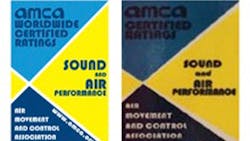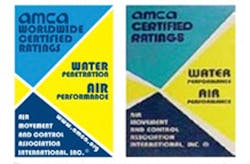Ensuring Products Are Indeed AMCA-Certified
Editor’s note: The following is a summary of the white paper “How to Ensure AMCA-Certified Products Get Installed.” For the full text, go to www.amca.org/whitepapers.
Air Movement and Control Association (AMCA) International’s Certified Ratings Program (CRP) provides third-party verification of product performance. When building-industry professionals properly specify an AMCA-certified product, they have assurance manufacturer-reported data are accurate. Shortcuts in specification, procurement, and installation, however, can lead to non-certified products being installed.
For assurance AMCA-certified products are installed:
1) Specifiers must be certain the product type is one AMCA certifies. Specifiers first should verify the product is within AMCA’s scope. For example, fans and dampers within air-handling units can be AMCA-certified, but AMCA does not certify air-handling units.
2) Specifiers should use AMCA’s online certified-product search. The most reliable and efficient method of finding AMCA-certified products is to search the certified-product database on AMCA’s website. The list is kept up-to-date and can be searched by product type, company, country, or license type.
3) Specifiers should verify certified-performance parameters. A product certified for a general license type may be certified only for specific parameters. For example, a louver displaying AMCA’s water-penetration and air-performance seal may be certified only for intake pressure drop and water penetration, not exhaust pressure drop. Performance parameters can be verified by checking AMCA’s certified-product database.
4) Specifiers should use language allowing only AMCA-certified products and reference AMCA publications. Specifications should list requirements for the performance of each product type and include statements mandating that each product be “certified to bear” the appropriate AMCA seal. Also, it is important that AMCA publications relevant to the certification needed be cited.
The wrong language could result in non-certified products being installed. Avoid specifying that a product be “tested in accordance with” AMCA literature and instead require the product to be “licensed to bear” a specific AMCA seal.
5) Owners or their designated representatives should verify certification authenticity. When a product arrives for installation, a number of checks can be performed to ensure the product is indeed AMCA-certified.
The first thing to check is that the product matches what was specified. After that, it is important to re-check AMCA’s online certified-product database to make sure the manufacturer did not commit a violation that led to the revocation of the product’s certification. While in the product database, specifiers can check to make sure the product and company name match the AMCA certification as listed online.
Next, specifiers can verify the authenticity of the AMCA seal. While certified products are not required to bear an AMCA seal, many manufacturers choose to display seals on their products. Unfortunately, counterfeit seals have been found (figures 1 and 2).
If a specified product bears what appears to be an AMCA seal, specifiers should check the appropriate AMCA publication to verify the seal on the product is identical. They should know, too, that the seal must be on the product itself. Seals appended to packaging are not permitted by the AMCA CRP.
If building-industry professionals follow these five steps, they can rest assured the performance data of the product they installed have been independently verified. Specifying AMCA-certified products and then carefully verifying product selection throughout the design and construction process will ensure products perform as described and expected.
Resources
AMCA International has three white papers providing general and specific information on the AMCA CRP. The following can be downloaded at no cost at www.amca.org/whitepapers:
• “How to Specify AMCA Certified Products”: An overview of the CRP, including a table listing all applicable products and matching them to appropriate rating test standards, seals, and governing-program publications.
• “Guideline Specifications for Selected AMCA-Certified Products”: Highly specific specification language that can be copied/pasted into office and project specifications worldwide.
• “How to Ensure AMCA-Certified Products Get Installed”: An overview of the AMCA CRP and how to properly specify AMCA-certified products, plus detailed information on how to ensure AMCA-certified products are procured and installed.
Michael Ivanovich is senior director, industry relations, and Lisa Ullrich is Certified Ratings Program manager for Air Movement and Control Association (AMCA) International.
Did you find this article useful? Send comments and suggestions to Executive Editor Scott Arnold at [email protected].


